Serotonin and the small cardioactive peptides differentially modulate two motor neurons that innervate the same muscle fibers in Aplysia
- PMID: 9236218
- PMCID: PMC6568356
- DOI: 10.1523/JNEUROSCI.17-16-06064.1997
Serotonin and the small cardioactive peptides differentially modulate two motor neurons that innervate the same muscle fibers in Aplysia
Abstract
The anterior portion of intrinsic buccal muscle 3 (I3a) is innervated by two motor neurons, B3 and B38, which appear to use glutamate as their fast excitatory transmitter. B3 and B38 express the neuropeptides FMRFamide and the small cardioactive peptides (SCPs), respectively. We have shown previously that stimulation of B38 causes release of the SCPs from terminals in the muscle. The I3a muscle also receives input from neurons that use 5HT as a modulatory transmitter. The SCPs and 5HT potently facilitated B38-evoked excitatory junction potentials (EJPs) but had only a small effect on B3-evoked EJPs; however, both the SCPs and 5HT strongly potentiated contractions evoked by both B3 and B38, indicating that the two substances must also act on excitation-contraction coupling. The selective facilitation of B38-evoked EJPs, however, did manifest itself in other parameters. Decreases in the firing frequencies and burst durations that were threshold to evoke contractions and decreases in the latency between the onset of a burst and the onset of the evoked contraction were all much larger for B38 than for B3. Indeed, B38 bursts recorded during feeding-like behavior would be subthreshold for evoking contractions in the absence of this modulation. All of the effects of the SCPs reversed during washout, whereas those of 5HT were persistent, lasting many hours after washout. Thus, the SCPs and 5HT dramatically change the behavioral output of these motor neurons, increasing the amplitude of contractions evoked by both B3 and B38, and shifting the temporal relationship between bursts in B38 and its evoked contractions.
Figures
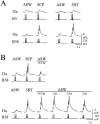

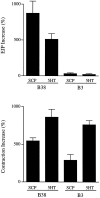
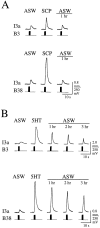




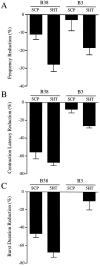
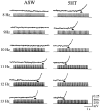

Similar articles
-
Modulation of neuromuscular transmission by conventional and peptide transmitters released from excitatory and inhibitory motor neurons in Aplysia.J Neurosci. 1993 Jul;13(7):2790-800. doi: 10.1523/JNEUROSCI.13-07-02790.1993. J Neurosci. 1993. PMID: 8392535 Free PMC article.
-
Serotonergic neurons differentially modulate the efficacy of two motor neurons innervating the same muscle fibers in Aplysia.J Neurophysiol. 1998 Aug;80(2):647-55. doi: 10.1152/jn.1998.80.2.647. J Neurophysiol. 1998. PMID: 9705458
-
Peptidergic and serotonergic facilitation of a neuromuscular synapse in Aplysia.Brain Res. 1990 Aug 27;526(1):81-94. doi: 10.1016/0006-8993(90)90252-7. Brain Res. 1990. PMID: 2078821
-
Functional roles of peptide cotransmitters at neuromuscular synapses in Aplysia.Mol Neurobiol. 1993 Fall-Winter;7(3-4):335-47. doi: 10.1007/BF02769181. Mol Neurobiol. 1993. PMID: 8179842 Review.
-
Physiology and biochemistry of peptidergic cotransmission in Aplysia.J Physiol Paris. 1993;87(3):141-51. doi: 10.1016/0928-4257(93)90025-o. J Physiol Paris. 1993. PMID: 7907908 Review.
Cited by
-
Multifaceted Expression of Peptidergic Modulation in the Feeding System of Aplysia.ACS Chem Neurosci. 2018 Aug 15;9(8):1917-1927. doi: 10.1021/acschemneuro.7b00447. Epub 2018 Jan 24. ACS Chem Neurosci. 2018. PMID: 29309115 Free PMC article. Review.
-
Excitatory neurotransmitters in the tentacle flexor muscles responsible for space positioning of the snail olfactory organ.Invert Neurosci. 2014 Mar;14(1):59-69. doi: 10.1007/s10158-013-0164-y. Epub 2013 Nov 2. Invert Neurosci. 2014. PMID: 24185528
-
The significance of dynamical architecture for adaptive responses to mechanical loads during rhythmic behavior.J Comput Neurosci. 2015 Feb;38(1):25-51. doi: 10.1007/s10827-014-0519-3. Epub 2014 Sep 4. J Comput Neurosci. 2015. PMID: 25182251 Free PMC article.
-
Mechanical reconfiguration mediates swallowing and rejection in Aplysia californica.J Comp Physiol A Neuroethol Sens Neural Behav Physiol. 2006 Aug;192(8):857-70. doi: 10.1007/s00359-006-0124-7. Epub 2006 Apr 4. J Comp Physiol A Neuroethol Sens Neural Behav Physiol. 2006. PMID: 16586084
-
Preparing the periphery for a subsequent behavior: motor neuronal activity during biting generates little force but prepares a retractor muscle to generate larger forces during swallowing in Aplysia.J Neurosci. 2015 Mar 25;35(12):5051-66. doi: 10.1523/JNEUROSCI.0614-14.2015. J Neurosci. 2015. PMID: 25810534 Free PMC article.
References
-
- Brezina V, Weiss KR. Analysis of ion currents mediating modulation of the ARC muscle of Aplysia by simultaneous on-line length measurements and current/voltage clamp. Soc Neurosci Abstr. 1993;19:1262.
-
- Brezina V, Orekhova IV, Weiss KR. Functional uncoupling of linked transmitter effects by combinatorial convergence. Science. 1996;273:806–810. - PubMed
-
- Calabrese RL. Modulation of muscle and neuromuscular junctions in invertebrates. Semin Neurosci. 1989;1:25–34.
Publication types
MeSH terms
Substances
Grants and funding
LinkOut - more resources
Full Text Sources
